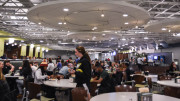Did you notice the student waste sign in GLAR before spring break? If not, you probably don’t eat in GLAR or are too busy to notice giant signs.
Either way, this sign recorded the amount of food wasted by students for the four consecutive weeks leading up to spring break.
The odd thing is the amount of food wasted by GLAR consumers increased each week, except for the very last week. So why is so much food, roughly between 3,000 and 7,000 pounds each week, wasted in GLAR?
Sodexo employees believe that one of the major factors is variety. McDaniel’s Sodexo Director, Rita Webster, said that “Studies have shown that when there is variety, people get more to eat.”
This makes sense given GLAR’s buffet-style dining and single rate charge for all you can eat.
Think about your experiences in a restaurant. When you choose a buffet option, you probably bring back several plates to your table, wind up throwing away whatever food you don’t like or got too much of, and then go up for more. However, if you choose an entrée, you probably choose something you like or are interested in trying and eat most or all of it. Less food is wasted.
Other colleges do have programs based on a point system and the specific food items are charged individually. A program like this might reduce waste in McDaniel, but there would surely be an outcry from students and faculty alike.
Many students value the variety of GLAR. Freshman Zach Royal said, “If something looks good, people want to try it, but if it’s gross, you shouldn’t be forced to eat something you don’t want. I don’t want anyone to stick with what they know. You shouldn’t be penalized for trying new things.”
GLAR’s buffet style allows students to try new food, but still provides an opportunity to get another plate if the student dislikes the new food, without charging anything extra.
So how can students reduce their own food waste in GLAR? Webster has addressed this problem by offering smaller portions, such as the half-sandwich and half-salad. She said that most of food thrown away by students consists of “salads, sandwiches, and wraps.”
Sodexo’s Stop Wasting Campaign tries to help students to be aware of their own waste. The waste sign in front of GLAR was a part of this campaign.
Webster said that part of her job is to make students “aware of waste and try to save food. I think people don’t realize that even half a sandwich less can make a difference.”
Webster has tried to educate students about waste and help them make conscious choices without forcing students into less variety. She suggests that when getting food, students, “think more about what they really like and want.”
Some students have a different opinion though, seeing the fault less on the student side. Royal believes that many students waste food because of quality. He would prefer if Sodexo “cut down on quantity and focused on quality. A lot of food being eaten is for the sake of needing to eat.”
The quality at Sodexo is limited by its contract with McDaniel. An increase in quality would likely be accompanied by a price increase in meal plans. If students do want better quality, as the consumers, they would have to demand it of the school.
For now, waste in GLAR can be decreased by simply asking for smaller portions and putting more consideration into food choices. Smaller portions can be requested. Additionally, Sodexo encourages comments on their new OrgSync page, or by talking to Sodexo employees. Reducing waste requires work both by students and by Sodexo, but the actions are simple.



